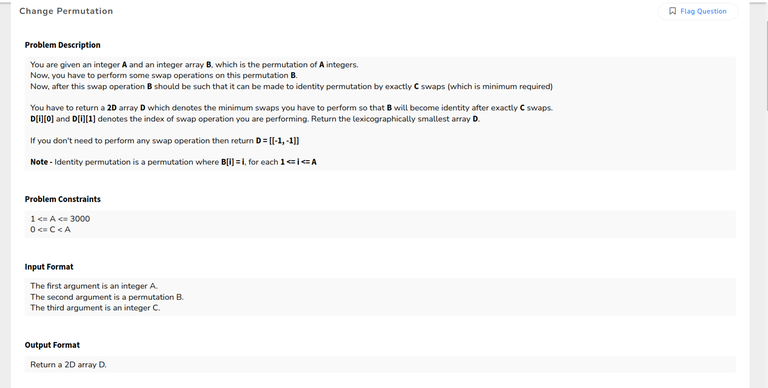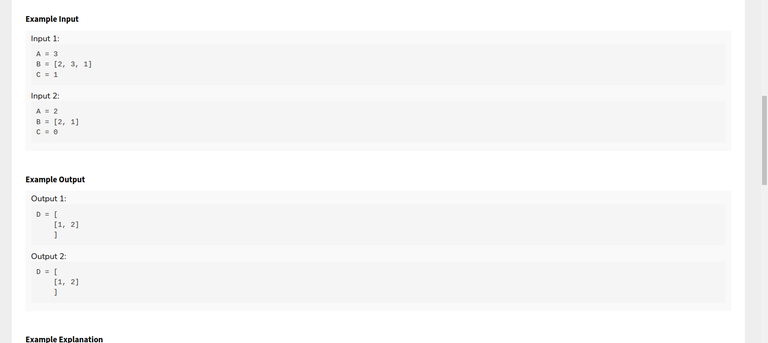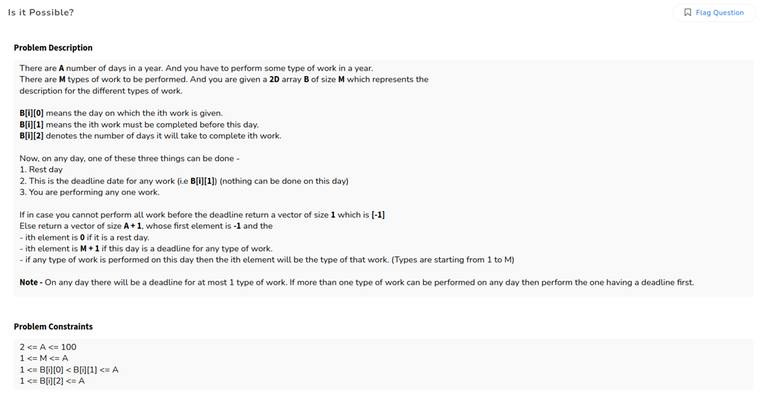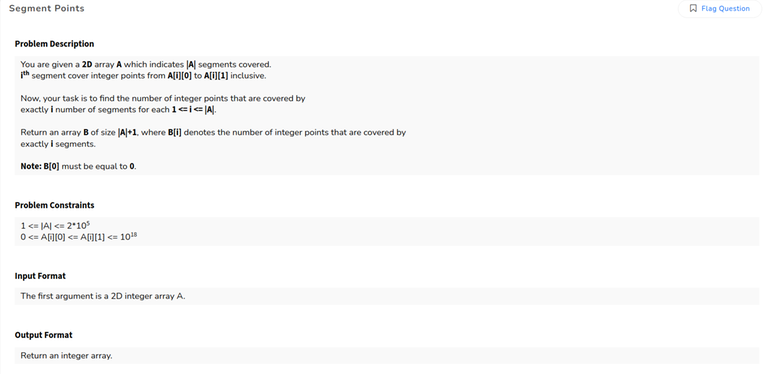Hello everyone,
Yesterday,Trilogy Innovations OA was held. There were 4 Questions and the time limit was 120 minutes. I am attaching all the questions. It would be really helpful, If we discuss the intuitions and Approaches to the problems. I felt Problems were Quite Interesting.
Change permutation
SubArray - AND - OR
Is It possible
Segment points
I personally felt first 2 problems were a bit challenging.
Thank You,
















Thanks for sharing...!!
In 4th problem i used difference array concept on map what did you do?
Yeah, Same
Solution sketches
A, write permutation as product of cycles, note that number of moves to change to identity is M = sum(c_i — 1), and doing a swap will change this value by +/- 1.
B, do each bit separately, now suppose A[i] <= 1. segment tree, state S[i..j] stores the answer to query type-3 and length of prefix/suffix of ones. operations are set=0, set=1, or nothing.
C, greedy, earlier due date has higher priority
D, sweep line (iterate over each interval-endpoint in sorted order)
Can u explain more on the solution for B ?
In problem B how would you combine the answers of multiple intervals while querying??
Can I code these problems in any coding platform?
2nd problem can be solved using lazy propagation. It's given that A[i] <= 31, which means we only need to consider first 5 bits. so let's solve the problem bit by bit. for any bit the array A will be a binary array. To find the number of subarrays in a range L, R satisfying the 3rd query, we only need to consider the subarrays having only 1's. This can be solved using segment trees. we just need to make a node to store the number of prefix 1's, suffix 1's, length of the range, and the number of subarrays having only 1's. The main task is to make a merge function for merging the left and right nodes of a segment tree. This would be easy if you are comfortable with segment trees. To solve the 1st query, you only need to assign a particular value to a given range which is a current bit of a given number that can be either 0 or 1. For the second query, think if a current bit is 0, this won't affect the range because x OR 0 gives you x. So update the range, only if a current bit is 1. To answer the 3rd query, iterate from 0th bit to the 4th bit and calculate the number of subarrays in a range having only 1's for a current bit. For a particular bit 'b', your answer will be (1 << b) * (the number of subarrays with only 1's). You need to add this answer for every bit ranging from 0 to 4.
Very nice. Love and support from Nepal.
Either I am missing something terribly simple or you might have left out a case for the query of 3rd type for this segment tree for some bit 'b'.
Consider this query of the third type: 3 2 6 0
There isn't a node that will cover exactly this range and the nodes that will return their answers will be [2-2], [3-4], and [5-6](I recommend looking at the segment tree I have drawn).
Wouldn't we need the following?
Of course, prefix 1's and suffix 1's in [2-2], [3-4] and [5-6] would be maintained in the segment tree but, what about the suffix 1's in [2-4]? Let me know if I am missing something or if you intended this will be handled in your solution, when you said:
"...The main task is to make a merge function for merging the left and right nodes of a segment tree. This would be easy if you are comfortable with segment trees..."
Merging the nodes (1, 2) and (3, 4) will handle the case.
So, we can just use values of the [1-4] node to get the suffix 1's for [2-4]. Now I understand, thanks for responding!
are you converting the number array entirely to a binary array? can you please explain your approach with a small example for all 3 queries?
Codeforces has a similar question to the third one https://mirror.codeforces.com/contest/978/problem/G